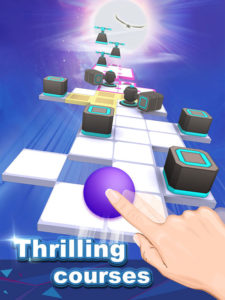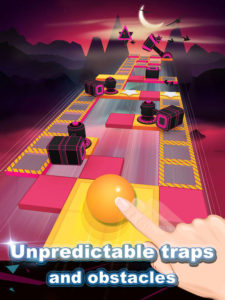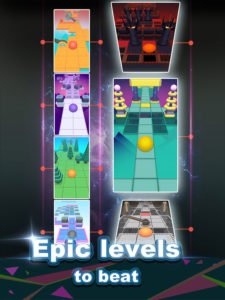Long-time readers of iFanzine are probably already quite aware that I loved last year’s Neon Drive (our review), which is — seeing as how the title made our 2015 Best Games list — perhaps putting things a bit mildly. My one lingering regret with Neon Drive is just how soul-crushingly unforgiving that title tended to be, a dilemma that was only partially remedied with a later re-tweaking of its difficulty. I wouldn’t necessarily say that Cheetah Technology’s Rolling Sky (out now, free) is actually easier, per se, but the game definitely features a vastly friendlier learning-curve during the first few stages.
 In Rolling Sky you’re tasked with keeping your ball safely rolling across ten neon-colored precariously-floating danger-filled musically-timed raceways, an experience that couldn’t help but to instantly remind me of Neon Drive (minus the invoked eighties aesthetic). You control this game by eternally holding a single finger on your iDevice’s screen, which you then slide back and forth to likewise control your ball to move across the track accordingly. These same controls work whether your ball is safely rolling along as solid-surface (warning: not all surfaces are as solid as they might otherwise initially seem), or if your ball is currently being tossed majestically through the air.
In Rolling Sky you’re tasked with keeping your ball safely rolling across ten neon-colored precariously-floating danger-filled musically-timed raceways, an experience that couldn’t help but to instantly remind me of Neon Drive (minus the invoked eighties aesthetic). You control this game by eternally holding a single finger on your iDevice’s screen, which you then slide back and forth to likewise control your ball to move across the track accordingly. These same controls work whether your ball is safely rolling along as solid-surface (warning: not all surfaces are as solid as they might otherwise initially seem), or if your ball is currently being tossed majestically through the air.
Something that bears further emphasis, even if it seems obviously inferable, is how this control-scheme creates a significant difference between how Rolling Sky and Neon Drive are both played. With Neon Drive’s controls you’d be expected to regularly make snap motions timed perfectly to the beat (doubly so with earlier builds), whereas in Rolling Sky you’ll often be able to successfully move yourself with less rigid timing. As a further consequence of the fact you no longer make perfect full-lane motions, the collision detection found within Rolling Sky is also way more forgiving than Neon Drive as well.
Additionally — whereas Neon Drive was predominantly focused on beat-based snap-reactions — Rolling Sky is more focused on players figuring on what the safest-path through a level might be, which is actually somewhat trickier than it might first seem. While Neon Drive generally made it fairly obvious what needed to be done next, Rolling Sky’s levels are filled with a plethora of moving — collapsing — and otherwise shifting parts for players to mentally sift through. Which is to say nothing of the various special-tiles littering the game’s ten courses, some of which can launch the ball skywards — some of which cause parts of the track to transform — and some which do still yet other things.
 While Rolling Sky’s scenarios are simultaneously far more dynamic and easily controlled than Neon Drive, that still leaves me with the — admittedly minor — wish the game’s neon-filled visuals were more eighties inspired. While Rolling Sky might lack radical cars ripping their way down a grid-filled runway — eventually launching themselves into space — and afterwards stopping an asteroid-barrage, it definitely has musically-synched action. One positive benefit of Rolling Sky not following Neon Drive’s eighties-fueled presentational-conceit — however — is that they’re enabled to cover a much wider berth of musical-styles, each of which manage to perfectly accompany their relevant-stages.
While Rolling Sky’s scenarios are simultaneously far more dynamic and easily controlled than Neon Drive, that still leaves me with the — admittedly minor — wish the game’s neon-filled visuals were more eighties inspired. While Rolling Sky might lack radical cars ripping their way down a grid-filled runway — eventually launching themselves into space — and afterwards stopping an asteroid-barrage, it definitely has musically-synched action. One positive benefit of Rolling Sky not following Neon Drive’s eighties-fueled presentational-conceit — however — is that they’re enabled to cover a much wider berth of musical-styles, each of which manage to perfectly accompany their relevant-stages.
Rolling Sky is even gracious enough to usually permit having these stages played out of order if you so wish (even if their steadily increasing difficulty makes that a fairly bad idea), a stark contrast to Neon Drive’s rigidly locked levels. The flip-side to this — sadly — is that one could indefinitely enjoy Fraoula’s epic offering, whereas Cheetah Technology’s Rolling Sky does admittedly contain a play-limiting energy system. Currently you can only run for ten consecutive failures — which doesn’t really take all that long to achieve — before you’re effectively cut off, after which you must either pay-up or wait for your balls to slowly recharge.
Fortunately Rolling Sky’s energy system isn’t nearly as bad as it might have otherwise ended up, with players being perpetually offered the chance to watch a single ad in order to receive a complete recharge (alternatively: twenty minutes also replaces all ten balls). Of course this isn’t always an option — especially for players in an area with bad service, or for those not using an iPhone — and for those people an infinite-ball unlock can be purchased for just $1.99 (this additionally prevents ads from ever randomly popping up). While you could alternatively receive a massive 500 ball stockpile for the admittedly lower price of $0.99, I seriously can’t think of a reason as to why — assuming you ever found yourself inclined to pay — you wouldn’t simply opt for the full-unlock instead.
 The other IAP-option found within Rolling Sky allows players to stock up on shields, which are single-use power-ups that enable you to survive a solitary impact — excluding any deaths due to plummeting — before your ball finally bites the dust. Although players can easily receive six of these by watching an ad, as well as occasionally receive some for successfully finishing a level, bulk-acquisition must be done exclusively via IAPs. This is definitely Rolling Sky’s biggest potential money-sink — considering there’s no infinite-supply option — and yet these shields aren’t really needed once you’ve learned a level correctly, since everything always plays out in a deterministic fashion.
The other IAP-option found within Rolling Sky allows players to stock up on shields, which are single-use power-ups that enable you to survive a solitary impact — excluding any deaths due to plummeting — before your ball finally bites the dust. Although players can easily receive six of these by watching an ad, as well as occasionally receive some for successfully finishing a level, bulk-acquisition must be done exclusively via IAPs. This is definitely Rolling Sky’s biggest potential money-sink — considering there’s no infinite-supply option — and yet these shields aren’t really needed once you’ve learned a level correctly, since everything always plays out in a deterministic fashion.
Thankfully the game’s so positively-enjoyable you’ll be more than willing to sink in the time needed to perfect each stage to such a degree, after which a level can be further replayed for the next plateau of mastery: gem-acquisition! Hidden across each level are twenty gems placed slightly off the beaten-path, and those seeking the ultimate-challenge will quickly find themselves rushing to further perfect their technique. However — other than existing as an additional challenge — I am not yet sure if these gems currently serve any other purpose, as I myself am still working on perfecting my Rolling Sky technique.
In conclusion: if you’ve ever found yourself wanting an app either reminiscent of Neon Drive — or just happen to like neon-filled challenges synchronized to music — then Rolling Sky is definitely one app you’ll want to check out, and it’s largely free to boot! Furthermore: the game still seems to be in active development, meaning even more challenging content will be made available in the near future (for instance: the tenth level was only very recently patched in). Finally — should you be afraid your current iDevice isn’t up to snuff — I can personally confirm my iPod Touch 5 never once crashed during any of the game’s 3D levels, or even whenever Rolling Sky loaded up an ad either!
Verdict
Rolling Sky is a neon-filled — musically-synchronized — game of skillful-dodging that might initially remind some of Fraoula’s Neon Drive, except containing a far friendlier difficulty-curve (as well as lacking the rad eighties-inspired racing-motif of Neon Drive). While the game may lack super-cars launching themselves into outer-space — and afterwards saving Earth from an asteroid-barrage — Rolling Sky compensates for this with a larger variety of stage themes, and musical genres to accompany their synched-action. Between tight controls — a largely non-aggressive IAP-structure — and an upfront free price-tag, this is certainly a game fans of last-year’s Neon Drive should certainly consider checking-out (especially if they found themselves wishing Neon Drive was a bit easier).


